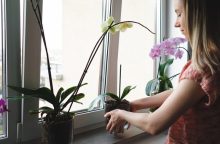Fern and how to transplant it correctly

Would you like to make your bright and nice bathroom even nicer and wondering what plant could help you to achieve that? Well, if your bathroom gets plenty of light a nice fern would do that. The conditions in your bathroom are ideal for ferns – moisture and light. Fern will make your bathroom cosier and it does not require any special care – so it is an ideal combination, right? Additional benefit is that ferns moisturize and clean the air – they absorb toxic substances from their surroundings. They are also believed to absorb radiation emitted by electronic devices.
Transplanting
If you feel that the container is no longer large enough, you need to transplant your fern and you should do so in the spring. Keep in mind that ferns are very susceptible to root damage and do not deal well with transplanting, but as they grow, sooner or later you need to do it. You need to be very careful, because even a slight damage may slow down the growth and make your fern susceptible to various diseases. Use a flower pot that is three to four centimetres larger than the old one. You do not want to do it again in the next year or so and endanger the plant. You will probably do another transplanting within few years.
Photo: Pixabay
Best flower pot for ferns?
Although growing ferns is relatively simple, you should know that they prefer ceramic containers and humidity. In order to meet both conditions, a good idea is to grow ferns in double pots. The inner smaller pot must have holes at the bottom and the outer larger pot has no holes. Fill the space between both pots with expanded clay, for example. This method will provide constant moisture and will protect the plant’s root from rotting.
How to transplant a fern
In order to reduce the risk of damage to the roots and make handling easier during transplanting, you need to water the plant abundantly in advance. Take a knife and loosen the substrate from the pot walls by running the knife all around the pot. Grab the plant right above the soil, carefully flip the container upside down and remove the plant. Place a layer of draining material and substrate on the bottom of the new flowerpot and then slide the plant in it. Add the substrate, but do not press too much on the substrate. A few days after transplanting check the soil. Keep it constantly moist.
Source: https://www.wikihow.cz/Jak-p%C4%9Bstovat-kapradiny
Preview photo: Pixabay

Gardening is my hobby, I have a lot of experience and I am happy to share it.









0 comments